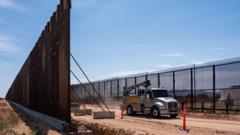The Trump administration has decided to paint the US-Mexico border wall black, a move aimed at making it more challenging to climb due to the increased heat that the color generates. Homeland Security Secretary Kristi Noem announced this strategy, attributing the concept to former President Donald Trump, who initiatives a new spending bill that allocated approximately $46 million for further border wall construction.
Construction is ongoing at a rapid pace, with an estimated half mile (0.8 km) of wall being erected daily along the extensive nearly 2,000-mile (3,218 km) border. The administration claims that the combination of intensified arrests and detentions is having a significant deterrent effect on illegal immigration, which has seen a marked decline in recent months.
During a recent press conference in New Mexico, Noem commented on the decision to paint the wall black, stating that it was done “specifically at the request of the president.” She explained how black surfaces absorb heat, making them more uncomfortable for climbers in the region's high temperatures. In addition to this feature, border officials mentioned that black paint could also aid in preventing rust on the wall.
Furthermore, Noem indicated plans for “waterborne infrastructure” along the Rio Grande, suggesting a broader strategy to bolster border security. Although specific details were scarce, Texas authorities have previously adopted measures such as floating barriers and fortified riverbanks protected by state and local enforcement.
Crossing numbers have reportedly plummeted under the current administration, with statistics showcasing record low arrests of around 4,600 in July and 6,000 in June—a drastic 92% drop from previous figures. In contrast, the Biden administration had seen average daily detentions soar to 6,000 at one point.
In a broader context, White House officials highlight that a significant number of undocumented immigrants have left the US during Trump's current term, claiming 1.6 million have exited in the first 200 days, although the exact figures of deportations versus voluntary departures remain unclear. Meanwhile, some immigration advocates caution that current crackdowns have led to the detention of non-criminal individuals, while officials maintain that their strategy is focused on individuals with criminal histories.
The administration continues to implement enhanced border security measures and mass deportations, asserting that these efforts have been crucial in reversing the trend of crossings at the US-Mexico border.





















